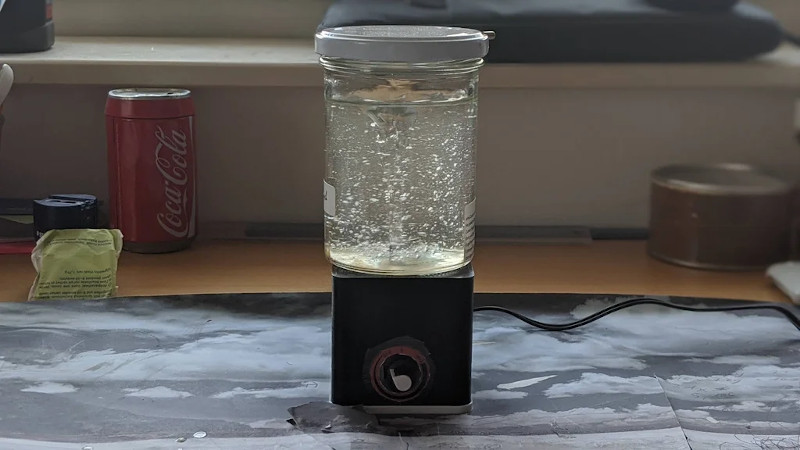When mixing or agitating delicate solutions in the chemistry lab, a magnetic stirrer is often the tool of choice. They’re able to be easily sterilized and cleaned, while maintaining isolation between the mechanical parts and the solutions in question. While they can be purchased off the shelf, [Max Siebenschläfer] whipped up a design that can easily be built at home.
The build consists of a 3D printed base, containing a simple brushed motor. This is hooked up to a motor controller fitted with a simple potentiometer for adjusting the speed of rotation. The motor is then fitted with a small 3D printed spinner containing two magnets. A similar 3D printed part acts as a stirrer, and is fitted with a matching pair of magnets, and dropped into the solution. The magnets in the stirrer are attracted to the ones on the end of the motor, and so when the motor spins, the stirrer spins in the solution, with no physical contact required.
It’s a simple way to build a magnetic stirrer at home without having to shell out big money for a laboratory grade unit. We imagine this could be put to fun use for stirring coffee or cocktails, too – if built with a food-grade spinner. More advanced designs are also possible for the eager home scientist. Video after the break.















Could one of those rattle magnets be used as the stirrer?
Good question because I don’t know how chemically reactive a 3D printed stirrer would be?
Most commercial grade chemical stirrers are coated in PTFE or some other plastic that specifically does not react to many chemicals. Despite that, I have chewed up a few over time.
You do not want the magnet material in your reaction. I know that Neodymium magnets will react with a lot of chemicals. I am also guessing they probably aren’t the healthiest materials to consume if you use this for food or brewing.
I love the DIY aspect of this but the stir bars only cost about $1 each when you buy a set.
Give me something that performs better or has more features and i am all in.
Barely. I tried that last weekend when I couldn’t find any. A rattle magnet will work badly or stall the motor on a commercial stir plate. Better to use a real one.
DIY magnetic stirrers are common in the homebrewing community, used to agitate and drive off CO2 i yeast starters. Often built from computer fans with glued on magnets and a speed controller. I’ve built a few myself.
You can buy teflon covered stirrer magnets very cheaply, so there’s very little worry about the plastic dissolving and contaminating your solution, and little chance of traces of the solution hiding in the printed plastic layers polluting the next solution you stir.
This is basically what I was just worrying about. Pla, abs, etc in your solution might ruin the results you’re after.
Not worth the effort. For $54 on Amazon you get hot plate with variable temp, stir speed control teflon stirbar.
That’s a useful comment for sure
Eh, those super cheap hotplates are pretty crappy. No temp control, relatively low max temp, and generally pretty weak stirrers. But hey, I use my hotplate for “proper” chemistry work. If you want a good one for hobby projects, I’d recommend buying one used.
Nice name. Would you recommend the $54 stirrer over the homemade stirrer?
Anyway, I was looking for a stir bar that agitates the circumference of the vessel, maybe https://www.fishersci.com/shop/products/nalgene-suspended-magnetic-stir-bars/p-4525883
Yes you should buy a new one, this one was created to remove PVA from 3D printed parts not being as strong. It should only create a constant water flow, but I also used it for mixing.
…and with a scrapped fan, and 1$ worth of magnets, you get it for free?
Please check what website you are currently visiting…
54$ is two weeks of food for some families in the 1st luxury world (and in other parts of the world, a years worth of fucking sustenance)
I’ve always wondered if you could just use the coils and (possibly a custom) speed controller of a brushless motor with the rotor removed to just drive something like a stir bar directly.
I too wonder the same.
It would effectively be a 2 pole motor with very low flux density, so the KV constant would be incredibly high. It may require an impractical amount of current to spin the stirrer directly with the necessary force, and would be very inefficient due to the I^2*R resistive losses.
The use of a proper brushless motor with any number of poles and high flux density gives you a reasonable KV constant to work with, trading voltage for current to achieve the same mechanical power with good enough efficiency. The coupling magnets coupling the motor to the stirrer aren’t converting electricity to kinetic energy so much as just transferring force, just as a physical coupler would do.
the bare stirrer bar has very little inertia, so it has no reason to just turn instead of jumping to one of the magnets…there’s a good reason why even pro gear has a spinny bit inside ;-)
Awesome! Makes me just a little nervous about the magnet going to the tanget due to the centripetal force and blasting the glass.
Their are to weak for this. They wouldn’t destroy the glass in any case.
Thanks For Publishing my design :)